This tutorial is not about FreeRTOS memory management options. Since we're using the heap_1.c model, there is no plan to free heap memory by deleting tasks or kernel objects after creation. Yet such approach with actually no memory management mechanism already covers a lot of application cases. Instead, the tutorial introduces the quite esoteric question of memory sizing for both the heap and the task stacks. And there's quite enough to say 'just' about that...
1. The Heap
The Heap represents the amount of RAM memory allocated for data placed under FreeRTOS control. It is the one reservoir of bytes that FreeRTOS uses for:
- Kernel objects data structures (Semaphores, Queues, ...)
- Tasks-associated data
The heap size is up to you.
This is done by defining the configTOTAL_HEAP_SIZE symbol in FreeRTOSConfig.h:
#define configTOTAL_HEAP_SIZE ( ( size_t ) ( 7 * 1024 ) )
How to size heap is a complex question. On one hand, you have a limited amount of RAM available in the device (16kB for STM32F072RB), therefore, you have a upper limit. Moreover, you probably need to store some data outside FreeRTOS scope (maybe global variables, DMA buffers, ...). And if you're using the trace recorder in snapshot mode, you need to keep some room for it also. On the other hand, we need enough memory for kernel objects and data used into tasks.
In the above example (and so far in these tutorials), the heap is set to 7kB (exactly 7168 bytes).
Is it enough? Is it too much?
Well, I don't know... I just can say "It has to be enough", given that it is close to a maximum considering that:
- I also want 4kB for trace recording (1000 events)
- I want to keep a little amount of memory apart for non-FreeRTOS stuff
Of course, this is not an acceptable answer. The less heap you have, the more limitations you will face in terms of:
- Number of possible kernel objects
- Number of possible tasks
- Amount of data processed by the tasks
The xPortGetFreeHeapSize() function returns the amount of free heap bytes. Let-us experiment this using the case study below.
/*
* main.c
*
* Created on: 01/04/2018
* Author: Laurent
*/
#include "main.h"
// Static functions
static void SystemClock_Config (void);
// FreeRTOS tasks
void vTask1 (void *pvParameters);
void vTask2 (void *pvParameters);
void vTaskHWM (void *pvParameters);
xTaskHandle vTask1_handle;
xTaskHandle vTask2_handle;
xTaskHandle vTaskHWM_handle;
// Kernel objects
xSemaphoreHandle xSem;
xSemaphoreHandle xConsoleMutex;
xQueueHandle xConsoleQueue;
// Define the message_t type as an array of 60 char
typedef uint8_t message_t[60];
// Trace User Events Channels
traceString ue1, ue2, ue3;
// Main program
int main()
{
uint32_t free_heap_size;
// Configure System Clock
SystemClock_Config();
// Initialize LED pin
BSP_LED_Init();
// Initialize Debug Console
BSP_Console_Init();
// Start Trace Recording
vTraceEnable(TRC_START);
// Report Free Heap Size
free_heap_size = xPortGetFreeHeapSize();
my_printf("\r\nFree Heap Size is %d bytes\r\n", free_heap_size);
// Create Semaphore object (this is not a 'give')
my_printf("\r\nNow creating Binary Semaphore...\r\n");
xSem = xSemaphoreCreateBinary();
vTraceSetSemaphoreName(xSem, "xSEM");
free_heap_size = xPortGetFreeHeapSize();
my_printf("Free Heap Size is %d bytes\r\n", free_heap_size);
// Create Queue to hold console messages
my_printf("\r\nNow creating Message Queue...\r\n");
xConsoleQueue = xQueueCreate(10, sizeof(message_t *));
vTraceSetQueueName(xConsoleQueue, "Console Queue");
free_heap_size = xPortGetFreeHeapSize();
my_printf("Free Heap Size is %d bytes\r\n", free_heap_size);
// Create a Mutex for accessing the console
my_printf("\r\nNow creating Mutex...\r\n");
xConsoleMutex = xSemaphoreCreateMutex();
vTraceSetMutexName(xConsoleMutex, "Console Mutex");
free_heap_size = xPortGetFreeHeapSize();
my_printf("Free Heap Size is %d bytes\r\n", free_heap_size);
// Register the Trace User Event Channels
my_printf("\r\nNow registering Trace events...\r\n");
ue1 = xTraceRegisterString("ticks");
ue2 = xTraceRegisterString("msg");
ue3 = xTraceRegisterString("HWM");
free_heap_size = xPortGetFreeHeapSize();
my_printf("Free Heap Size is %d bytes\r\n", free_heap_size);
// Create Tasks
my_printf("\r\nNow creating Tasks...\r\n");
xTaskCreate(vTask1, "Task_1", 128, NULL, 2, &vTask1_handle);
xTaskCreate(vTask2, "Task_2", 128, NULL, 3, &vTask2_handle);
xTaskCreate(vTaskHWM, "Task_HWM", 128, NULL, 1, &vTaskHWM_handle);
free_heap_size = xPortGetFreeHeapSize();
my_printf("Free Heap Size is %d bytes\r\n", free_heap_size);
// Start the Scheduler
my_printf("\r\nNow Starting Scheduler...\r\n");
vTaskStartScheduler();
while(1)
{
// The program should never be here...
}
}
Then provide an ultra-minimal implementation for the three tasks:
/*
* Task_1
*/
void vTask1 (void *pvParameters)
{
while(1)
{
// Wait for 100ms
vTaskDelay(100);
}
}
/*
* Task_2
*/
void vTask2 (void *pvParameters)
{
while(1)
{
// Wait for 100ms
vTaskDelay(100);
}
}
/*
* vTaskHWM
*/
void vTaskHWM (void *pvParameters)
{
while(1)
{
// Wait for 100ms
vTaskDelay(100);
}
}
Now take a look at the console during initializations:
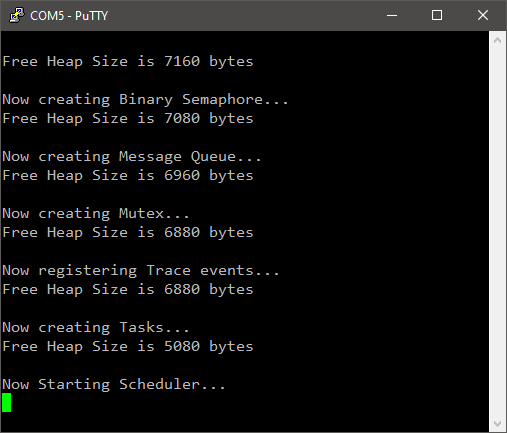
At the beginning of code execution, we've got 7160 bytes available. That's our 7kB of total heap, minus 2 words (assume FreeRTOS has good use for these).
- Creating the Binary Semaphore took 80 bytes of heap memory
- Creating the Message Queue took 120 bytes of heap memory
- Creating the Mutex took 80 bytes of heap memory
- Registering trace events took nothing in the heap
- Creating the three tasks took 1800 bytes of heap memory (presumably 600 bytes for each of the 3 tasks)
The memory taken from the heap for each task is made of two segments:
- The task stack
- The Task Control Block (TCB)
The TCB size is the same for all tasks and it is a FreeRTOS port feature. Here, we have 88 bytes for TCBs.
The stack size is a user setting, passed as third argument to the xTaskCreate() function. In our example, stack is set to 128 words (i.e. 512 bytes).
xTaskCreate(vTask1, "Task_1", 128, NULL, 2, &vTask1_handle);
So what about this 128 words stack. Is it enough? Is it too much?
Well again, I don't know...
It depends on what tasks are actually doing. More precisely, it depends on the amount of data each task is manipulating (either directly using local variables, or indirectly by calling functions that manipulate variables), and what needs to be saved when (or if) task is preempted. Remember that when a task is preempted by another task, the OS saves all the information required for further recovery into the stack.
In the above example, tasks are pretty much doing nothing. There's no local variables, and a single call to vTaskDelay(). Therefore, a small stack should be enough...
Anyway, if the heap or the task stacks are sized too small, you'll probably end up with an application crash... but nothing will tell you the reason it occurred, unless you take care of it... see later.
 |
 Commit name "Heap memory" Commit name "Heap memory" Push onto Gitlab Push onto Gitlab |
2. Stack High Water Mark
Stacks are used to store task local variables, and any temporary data required for recovery before a task is preempted. Therefore, the amount of instantaneous stack in use continuously fluctuates during application life. FreeRTOS provides a mechanism to calculate the maximum amount of stack memory that has been (at least once) required since the application started. Internally, what this mechanism does is an initial "painting" (at creation time) of the stack RAM segment with a regular pattern. Figure below shows this painting with a uniform 0xA5 pattern (1010 0101).

When the stack is used (at runtime), the painting is overridden (scratched) by meaningful data. The FreeRTOS uxTaskGetStackHighWaterMark() function implements an algorithm that searches for remaining initial paint within the stack and then determines the amount of unused stack. Think of it as a flood in your house. The watermark you get on the walls at a given time corresponds to the highest level the water ever reached. That explains the name for High Water Mark. The uxTaskGetStackHighWaterMark() function actually return the number of words (4-bytes unit) above the watermark (i.e. the remaining space into the stack).
In order have the uxTaskGetStackHighWaterMark() function available, you first need to activate the mechanism in FreeRTOSConfig.h:
/* Set the following definitions to 1 to include the API function, or zero
to exclude the API function. */
#define INCLUDE_vTaskPrioritySet 0
#define INCLUDE_uxTaskPriorityGet 0
#define INCLUDE_vTaskDelete 0
#define INCLUDE_vTaskCleanUpResources 0
#define INCLUDE_vTaskSuspend 0
#define INCLUDE_vTaskDelayUntil 1
#define INCLUDE_vTaskDelay 1
#define INCLUDE_uxTaskGetStackHighWaterMark 1 // <-- Add this line
Let-us now experiment this. The purpose of the Task_HWM is actually to periodically report the high watermarks for both Task_1, Task_2 and itself into the console.
/*
* vTaskHWM
*/
void vTaskHWM (void *pvParameters)
{
uint32_t count;
uint16_t hwm_Task1, hwm_Task2, hwm_TaskHWM;
uint32_t free_heap_size;
count = 0;
// Prepare console layout using ANSI escape sequences
my_printf("%c[0m", 0x1B); // Remove all text attributes
my_printf("%c[2J", 0x1B); // Clear console
my_printf("%c[1;0H", 0x1B); // Move cursor [1:0]
my_printf("High Water Marks console");
my_printf("%c[3;0H", 0x1B); // Move cursor line 3
my_printf("Iteration");
my_printf("%c[4;0H", 0x1B); // Move cursor line 4
my_printf("Task1");
my_printf("%c[5;0H", 0x1B); // Move cursor line 5
my_printf("Task2");
my_printf("%c[6;0H", 0x1B); // Move cursor line 6
my_printf("TaskHWM");
my_printf("%c[7;0H", 0x1B); // Move cursor line 7
my_printf("Free Heap");
while(1)
{
// Gather High Water Marks
hwm_Task1 = uxTaskGetStackHighWaterMark(vTask1_handle);
hwm_Task2 = uxTaskGetStackHighWaterMark(vTask2_handle);
hwm_TaskHWM = uxTaskGetStackHighWaterMark(vTaskHWM_handle);
// Get free Heap size
free_heap_size = xPortGetFreeHeapSize();
// Reports watermarks into Trace Recorder
vTracePrintF(ue3, (char *)"1[%d] 2[%d] HWM[%d]",
hwm_Task1,
hwm_Task2,
hwm_TaskHWM );
// Display results into console
my_printf("%c[0;31;40m", 0x1B); // Red over black
my_printf("%c[3;12H", 0x1B);
my_printf("%5d", count);
my_printf("%c[1;33;44m", 0x1B); // Yellow over blue
my_printf("%c[4;12H", 0x1B);
my_printf("%5d", hwm_Task1);
my_printf("%c[5;12H", 0x1B);
my_printf("%5d", hwm_Task2);
my_printf("%c[6;12H", 0x1B);
my_printf("%5d", hwm_TaskHWM);
my_printf("%c[1;35;40m", 0x1B); // Majenta over black
my_printf("%c[7;12H", 0x1B);
my_printf("%5d", free_heap_size);
my_printf("%c[0m", 0x1B); // Remove all text attributes
count++;
// Wait for 200ms
vTaskDelay(200);
}
}
I couldn't resist playing with ANSI escape sequences to bring some fun into the console display, although this not quite essential here.
Still, if you like it, see more there: https://en.wikipedia.org/wiki/ANSI_escape_code
The console then reports:
- The remaining amount of stack for each task (in 4-bytes words)
- The remaining amount of heap (in bytes)

None of the above is zero, or even close to zero, therefore, I can now temporarily answer the questions:
- Do we have heap memory enough? → Yes, maybe too much actually. Yet, one can see that starting the scheduler took an additional 1344 bytes on the heap (5080-3756). That's because FreeRTOS created internal tasks (such as the IDLE task, timer task, ...) and objects.
- Do we have stack memory enough? → Yes, but not too much as we should stay somehow far from zero. Both stacks associated with Task_1 and Task_2 have been used up to 41 words (128-87). Also note that 70 words is the minimal stack size defined in FreeRTOSConfig.h:
#define configMINIMAL_STACK_SIZE ( ( unsigned short ) 70)
Above answers are only valid for the current application, which does actually nothing useful. If we want the tasks to perform something real, answer may probably be different.
Now, let us shorten Task_1 and Task_2 wake-up period in order to increase the density of Task_HWM preemption events:
/*
* Task_1
*/
void vTask1 (void *pvParameters)
{
while(1)
{
// Wait for 20ms
vTaskDelay(20);
}
}
/*
* Task_2
*/
void vTask2 (void *pvParameters)
{
while(1)
{
// Wait for 30ms
vTaskDelay(30);
}
}
Launch the application and watch the console. Reaching iteration #9, the watermark for Task_HWM drops from 50 to 42:
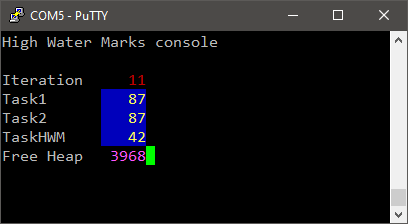
As said before, the stack is used to save task information when it is preempted. Therefore, the amount of data to save totally depends on the very moment the preemption occurs. Considering Task_HWM, there is a strong probability that preemption occurs during a call to my_printf() function. In that case, the current state (variables) of my_printf() function are saved into Task_HWM stack. If you're not lucky, you might never catch the worst situation.
What the above experiment demonstrates, is:
- You will never be 100% sure that watermarks you get represents the worst case of stack usage
- The longer you'll leave application running, trying to cover a lot of application situations, the closer you should get from the 'true' worst case
Now, let us add some data into Task_1 and Task_2:
/*
* Task_1
*/
void vTask1 (void *pvParameters)
{
uint8_t msg[] = "This is task_1 message"; // 22 bytes string
while(1)
{
// Send message to Trace Recorder
vTracePrint(ue2, (char *)msg);
// Wait for 20ms
vTaskDelay(20);
}
}
/*
* Task_2
*/
void vTask2 (void *pvParameters)
{
uint8_t msg[] = "This is a much longer task_2 message"; // 36 bytes string
while(1)
{
// Send message to trace Recorder
vTracePrint(ue2, (char *)msg);
// Wait for 30ms
vTaskDelay(30);
}
}
The corresponding trace:
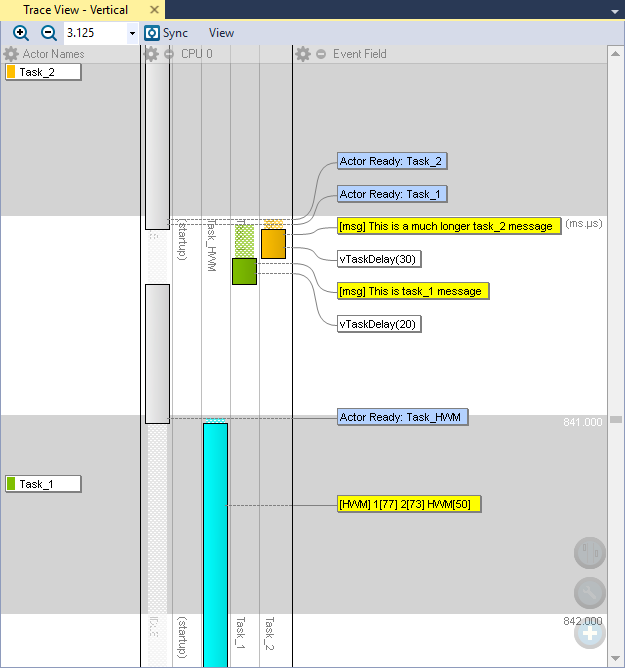
And our HWM console:

High watermarks dropped from the previous 87 for both Task_1 and Task_2 tasks to 73 and 69 respectively. Stored strings are 36 and 22 bytes long, so that difference is 14 bytes, leading to the observed 4 words difference between Task_1 and Task_2 watermarks. Yet, the 36 bytes string only takes 9 words (36/4) in memory and the reported 69 watermark for Task_2 is below the expected 87-9 = 78 (same thing for Task_1).
Calling vTracePrint() function has its own footprint into the stack, but that's not enough to explain the difference (actually, commenting the vTracePrint() call would raise the watermark by 4 words only).
 |
 Commit name "Stack memory" Commit name "Stack memory" Push onto Gitlab Push onto Gitlab |
3. Crash Test
3.1. Insufficient Heap
According the above measurements, we need 7168-3968 = 3200 bytes of heap memory to fit all the kernel objects and tasks in our application.
What if we set the heap size below this requirement?
Well, let us experiment with 3kB of heap memory:
#define configTOTAL_HEAP_SIZE ( ( size_t ) ( 3 * 1024 ) )
Build ![]() the application, start a debug session
the application, start a debug session ![]() and step over
and step over  initialization code. Everything goes well until you start the scheduler. Then, the application freezes. Hit the suspend
initialization code. Everything goes well until you start the scheduler. Then, the application freezes. Hit the suspend  button:
button:

Well, at least, that's pretty clear...
Consider you're lucky if the scheduler didn't start. Way more dangerous is the case everything starts well, but you fail creating a kernel objects during application life (i.e. after scheduler is started). As a matter of fact, nothing impose kernel objects to be created at initialization.
One way to address such issue would be to implement a dynamic memory allocation failure hook function. First, you must enable this feature in FreeRTOSConfig.h by enabling configUSE_MALLOC_FAILED_HOOK:
#define configUSE_MALLOC_FAILED_HOOK 1
Then, you'll need to provide your own implementation of the function vApplicationMallocFailedHook(). Let us write something basic in main.c: This hook does nothing, but at least it provides a way to catch the problem in the debugger.
/*
* Malloc failed Basic Hook
*/
void vApplicationMallocFailedHook()
{
while(1);
}
Repeat the above experiment now. After the program freezes, hit the suspend  button. I you should end-up in your hook function:
button. I you should end-up in your hook function:

In a real scenario, you can use such hook to allow watchdog application reset and use that knowledge to avoid further attempts to create the failing object.
For now, just restore Heap size to 7kB before proceeding to next experiment.
3.2. Stack overflow
Say now we need to call a function that requires its own amount of memory to execute. For instance, let us computes the cumulative weighted sum of an array of integers:
/*
* sum_prod function
*
* Calculate y the sum of (x * coef[n])
* x is a floating point number
* coef[n] is an array of 120 32-bit integers
*
* returns y a floating point number
*/
float sum_prod(float x)
{
uint32_t coef[120];
float y;
uint8_t n;
// Initialize array
for (n=0; n<120; n++) coef[n] = n;
// Calculate sum of products
y = 0;
for (n=0; n<120; n++) y += x * coef[n];
return y;
}
Now, we implement a call to this function within Task_2, but only if the user push-button is pressed. To do that, we'll use the EXTI #13 interrupt signal to give a semaphore to Task_2:
/*
* Task_2
*/
void vTask2 (void *pvParameters)
{
uint8_t msg[] = "This is a much longer task_2 message"; // 36 bytes string
float x,y;
// Initialize the user Push-Button
BSP_PB_Init();
// Set maximum priority for EXTI line 4 to 15 interrupts
NVIC_SetPriority(EXTI4_15_IRQn, configLIBRARY_MAX_SYSCALL_INTERRUPT_PRIORITY + 1);
// Enable EXTI line 4 to 15 (user button on line 13) interrupts
NVIC_EnableIRQ(EXTI4_15_IRQn);
// Take the semaphore once to make sure it is cleared
xSemaphoreTake(xSem, 0);
// Now enter the task loop
while(1)
{
// Wait here endlessly until button is pressed
xSemaphoreTake(xSem, portMAX_DELAY);
// Compute y
x = 1.0f;
y = sum_prod(x);
// Send message to trace Recorder
vTracePrint (ue2, (char *)msg);
vTracePrintF(ue2, (char *)"%d", (uint32_t)y);
}
}
Make sure that EXTI #13 interrupt handler is well written in stm32f0xx_it.c:
/**
* This function handles EXTI line 13 interrupt request.
*/
extern xSemaphoreHandle xSem;
void EXTI4_15_IRQHandler()
{
portBASE_TYPE xHigherPriorityTaskWoken = pdFALSE;
// Test for line 13 pending interrupt
if ((EXTI->PR & EXTI_PR_PR13_Msk) != 0)
{
// Clear pending bit 13 by writing a '1'
EXTI->PR = EXTI_PR_PR13;
// Release the semaphore
xSemaphoreGiveFromISR(xSem, &xHigherPriorityTaskWoken);
// Perform a context switch to the waiting task
portEND_SWITCHING_ISR(xHigherPriorityTaskWoken);
}
}
And leave Task_1 as something minimal:
/*
* Task_1
*/
void vTask1 (void *pvParameters)
{
uint8_t msg[] = "This is task_1 message"; // 22 bytes string
while(1)
{
// Send message to Trace Recorder
vTracePrint(ue2, (char *)msg);
// Wait for 100ms
vTaskDelay(100);
}
}
 |
 Commit name "Crash test" Commit name "Crash test" Push onto Gitlab Push onto Gitlab |
Build and fire the application. Watch the console reporting watermarks (do not press the button yet). You should see your watermarks at safe level, and everything doing good as expected.
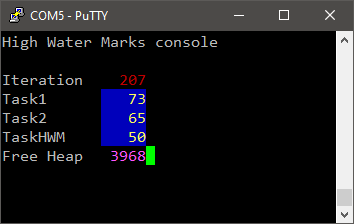
Now press the user-button... and something bad should happen!
Depending on 'when' the button is pressed, you may experience two different behaviors.
- Case #1 : Application crash
In that case, the console just freezes after you pressed the button:
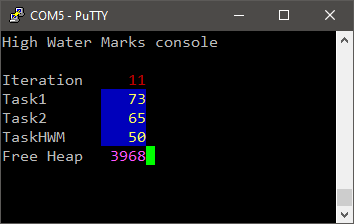
Looking at the trace, you'll see that Task_2 execution was the very last event to be recorded, and then nothing... Application has died, silently...
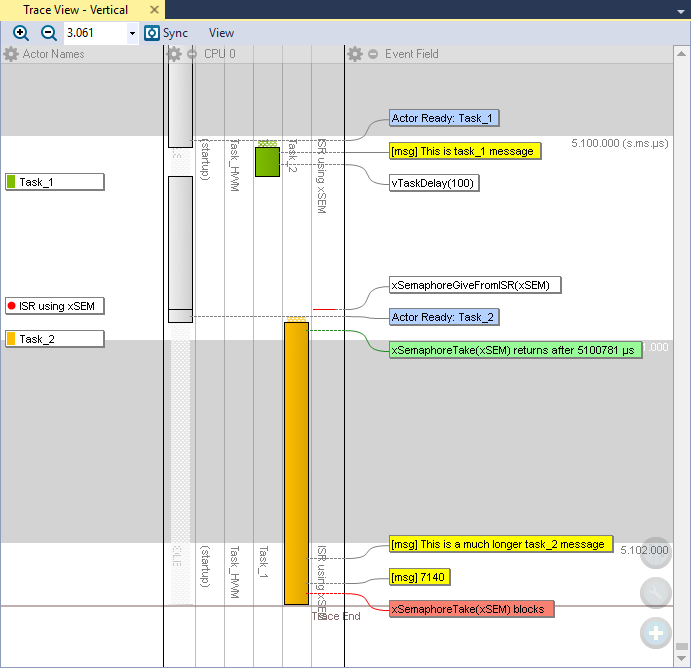
If you're curious enough to suspend the debugger there, you'll find out that application seems caught in the IDLE task forever...
- Case #2 : Application keeps running but watermarks dropped to zero
In that case, the Task_HWM keeps running and reports both stacks remaining space to zero:
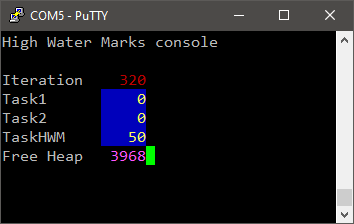
Which is confirmed by the trace:
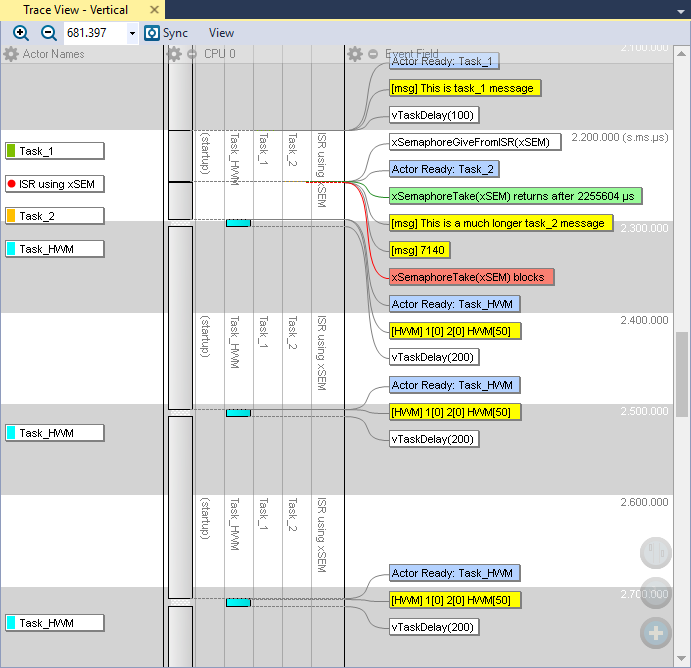
The reason Task_2 stack overflew is quite obvious. Calling the sum_prod() function requires the stack size to cope with a large array of 32-bit integers. The surprise comes from Task_1 stack which appear to be corrupted as well by the Task_2 stack overflow... Or maybe the watermark algorithm get lost somewhere.
Both cases are bad. But again, what the above experience teaches you, is that you can miss stack overflow if you forget to test the button case.
FreeRTOS can help you track stack overflows. First go to FreeRTOSConfig.h and enable configCHECK_FOR_STACK_OVERFLOW the feature:
#define configCHECK_FOR_STACK_OVERFLOW 1
Then, you'll need to provide your own implementation of the function vApplicationStackOverflowHook(). Let us write something basic in main.c:
/*
* Stack Overflow Basic Hook
*/
void vApplicationStackOverflowHook()
{
while(1);
}
Unfortunately, depending on the severity of the problem, the hook does not always work. You may end up into the Hardfault handler as well...


Add new comment